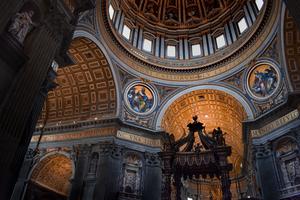Museum of the Bible Offers New Glimpse of the Pilgrim Churches of Rome in Vatican Library Exhibit
The D.C. museum is displaying a series of prints showcasing seven Roman churches and ancient pilgrimage routes.

WASHINGTON — The Museum of the Bible is inviting visitors to immerse themselves in the beauty of the ancient tradition of pilgrimage with a fresh look at the seven pilgrim churches of Rome through a series of prints of the churches on loan from the Vatican Library.
The exhibit “A Journey of Faith: The Seven Pilgrim Churches of Rome” opened on May 12 as part of the museum’s partnership with the Vatican Library and also features pilgrim maps and artifacts.
The seven pilgrim churches were originally the Basilica of St. John Lateran, St. Peter's Basilica, the Basilica of St. Paul Outside the Walls, the Basilica of St. Mary Major, the Basilica of St. Lawrence Outside the Walls, the Basilica of the Holy Cross in Jerusalem and St. Sebastian Outside the Walls.
In the jubilee year 2000, Pope St. John Paul II replaced St. Sebastian Outside the Walls with the Sanctuary of Our Lady of Divine Love.
Jeffrey Kloha, chief curatorial officer at the Museum of the Bible, told the Register at the exhibit’s opening that the prints afford an opportunity to appreciate the beauty of the ancient churches and the beauty of pilgrimage.
“It’s just stunning to see what St. Peter’s looked like in 1575, right before it’s completed, and these original basilicas from the fourth century, St. John Lateran; but we also wanted to highlight the role of pilgrimage and that these churches were designated as a special time of retreat.”
Kloha called the exhibit’s prints of pilgrim maps from 1575 and 1590 depicting statues of the saints in front of the churches “a great visual representation of what pilgrimage is all about: visiting places, learning from the saints, doing this together from all around the world.”
He said the exhibit contains an important message for our busy lives.
“The need to step back and even to go somewhere else and reflect, learn from those who have gone before us, to be in places of beauty, to be in sacred places, to be refreshed and empowered to go back into our everyday lives in a new way,” he said. “I think it’s an important discipline.”
He said the museum was “honored” by their partnership with the Vatican Library to “be able to share some of those treasures here in Washington, D.C.”
Rome Comes to the Museum of the Bible
Maria Adalgisa Ottaviani, head of the exhibition office for the Vatican Library, told those gathered at the exhibit’s opening that “the works on display here accompany the visitor on a kind of journey touching on the most important places of worship in Rome where the relics of the apostles Peter and Paul are still present today.”
She added that the Vatican Library “fully shares the purpose which inspires the Museum of the Bible in conceiving this exhibition” to “propose to today’s tourists and visitors of the museum a reminder of a custom that has fallen into disuse: the tour of the seven churches of Rome, which has the value of spiritual reflection, research and contact with the divine, a kind of fascinating moment of great faith.”
Archbishop Christophe Pierre, apostolic nuncio to the U.S., told the Register at the exhibit’s opening that he is “full of admiration” for the Museum of the Bible’s work with the Vatican Library. “The Vatican Library is exposing something of its patrimony,” he said, “especially this pilgrimage in the seven churches, which is a long tradition in Rome.”

In the pilgrim churches, he said, “you have the two tombs, the tomb of Peter and the tomb of Paul, which were the beginning of the basilicas and which is now St. Peter’s and St. Paul Outside the Walls. Basically, the people came to go to the roots of their faith, and it became a tradition.”
“It's very meaningful that in the Museum of the Bible, where people are actually keeping together not only old Bibles, but also the old traditions,” he said, “this history continues, particularly in Rome and Rome comes to the Museum of the Bible.”
A Virtual Pilgrimage
Archbishop Pierre also praised the exhibit’s emphasis on the idea of pilgrimage. “Pilgrimage is always to go out of your zone of comfort, to go out of your house, to go out of your culture, to go somewhere else where something happened,” he said, “to receive precisely the witness of these things which happened somewhere else and to be impacted, to be transformed, to be converted by this, the Good News of the Gospel.”
Amy Van Dyke, lead curator of art and exhibitions at Museum of the Bible, told the Register that visitors may not be able to journey to Rome themselves, “but they can come here and do their own virtual pilgrimage, in a sense. To go look at each of these prints and each of the churches and think [about], ‘Why were they built there? What’s housed there? Why are they important? Why are they sacred?’”
“You can walk the same path that many others have walked virtually here,” she said. “We think that idea of pilgrimage, of a physical journey of faith is very important for so many people of faith, especially Catholics, and so we want to represent that and really honor the tradition of pilgrimage and all the people that have done it in the past for so many years.”
LEARN MORE
The exhibit is open through Sept. 10, and the museum plans to feature activities for children and visiting schools connected to the exhibit. Visit MuseumoftheBible.org/exhibits/the-seven-pilgrim-churches-of-rome.
- Keywords:
- museum of the bible
- vatican library

















